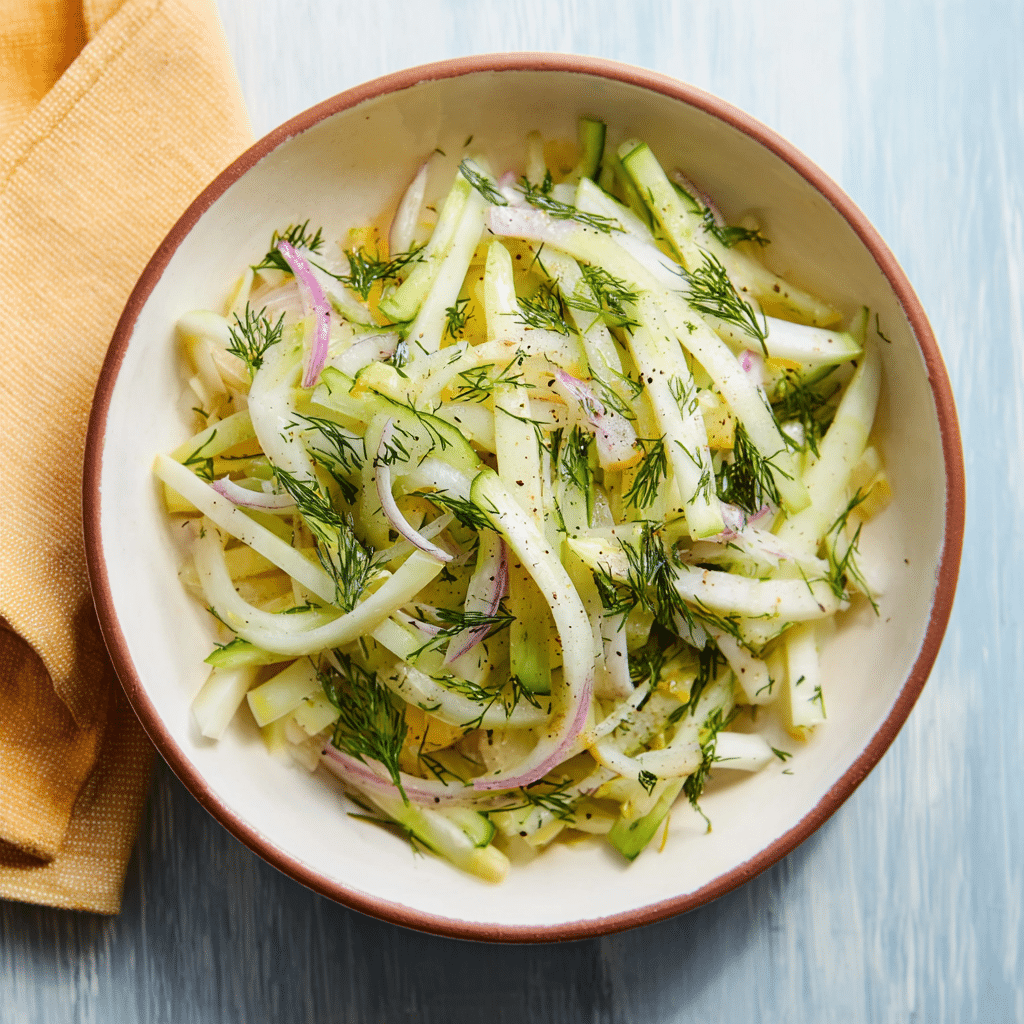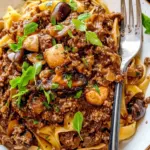If you’ve never tried kohlrabi raw, you’re in for a treat. This vibrant, crunchy vegetable has a mild, slightly sweet flavor—perfect for shredding or slicing into refreshing salads. When combined with fresh cucumber, zesty red onion, and fragrant dill, it becomes the star of a light, crisp dish that’s ideal for warm-weather dining or as a palate cleanser alongside heavier mains.
The lemon-dill vinaigrette adds a burst of brightness, tying all the ingredients together with tang and herbal freshness. This salad is naturally gluten-free, low in carbs, and vegan-friendly—making it a great option for anyone looking to eat clean without sacrificing flavor. Customize it with your favorite toppings, and it’s ready to serve in just 15 minutes!
Full Recipe
Ingredients:
-
2 medium kohlrabi bulbs, peeled and julienned
-
1 small cucumber, thinly sliced
-
1/4 red onion, thinly sliced
-
1/4 cup chopped fresh dill
-
3 tablespoons olive oil
-
1 tablespoon white wine vinegar
-
1 tablespoon fresh lemon juice
-
1 teaspoon Dijon mustard
-
Salt and freshly ground black pepper, to taste
-
Optional: crumbled feta or toasted sunflower seeds for topping
Directions:
-
In a small bowl, whisk together olive oil, white wine vinegar, lemon juice, Dijon mustard, salt, and pepper to make the vinaigrette.
-
In a large salad bowl, combine the julienned kohlrabi, cucumber, red onion, and chopped dill.
-
Pour the vinaigrette over the salad and toss well to combine.
-
Let the salad rest for 10–15 minutes before serving to allow the flavors to meld.
-
Garnish with feta or sunflower seeds if desired.
Prep Time: 15 minutes | Cooking Time: 0 minutes | Total Time: 15 minutes
Kcal: 120 kcal | Servings: 4 servings
Introduction to Kohlrabi Salad
Kohlrabi salad is a fresh, crisp, and refreshing dish that brings out the best qualities of this underappreciated vegetable. Known for its crunchy texture and subtly sweet flavor, kohlrabi is a member of the brassica family, which includes cabbage, broccoli, and kale. Its firm flesh makes it ideal for raw preparations, especially when paired with complementary ingredients like cucumber, red onion, lemon juice, and fresh herbs. This salad is perfect for those seeking healthy, nutrient-dense meals that are light yet satisfying. It makes a beautiful addition to summer tables, potlucks, lunchboxes, and even as a side for heavier entrees.
Understanding Kohlrabi and Its Role in the Salad
Kohlrabi may look intimidating at first glance with its bulbous shape and stems extending in different directions, but it is surprisingly easy to prepare and quite versatile. Its flavor is somewhere between a mild radish and a tender broccoli stem, with a hint of apple-like sweetness. When used in a salad, kohlrabi offers a crisp, juicy bite that holds up well to dressings without becoming soggy, making it ideal for make-ahead dishes.
Raw kohlrabi, when julienned or thinly sliced, provides a fantastic base for a slaw-style salad. It pairs exceptionally well with tangy vinaigrettes, sharp onions, and fresh herbs. The addition of lemon juice and vinegar enhances its natural sweetness while cutting through its dense crunch, allowing it to absorb flavor and remain texturally interesting. Its pale green color also adds visual freshness to any plate.
Nutritional Benefits of Kohlrabi Salad
One of the major appeals of kohlrabi salad is its high nutritional value. Kohlrabi is low in calories and carbohydrates but high in dietary fiber, making it a fantastic option for those managing weight, blood sugar, or cholesterol. It’s rich in vitamin C—an important antioxidant that supports immune health, skin integrity, and iron absorption. It also contains potassium, which is essential for heart and muscle function, and vitamin B6, which helps with brain development and mood regulation.
Because this salad is also packed with cucumber, dill, red onion, and an olive oil-based vinaigrette, it brings a wide spectrum of nutrients to the table. Cucumbers offer hydration and additional fiber, onions add prebiotics for gut health, and olive oil provides heart-healthy monounsaturated fats. When topped with extras like feta cheese or sunflower seeds, the salad becomes even more balanced with the addition of protein and healthy fats.
The Versatility of Kohlrabi Salad
One of the reasons kohlrabi salad has become a favorite among foodies and health-conscious eaters is because of its versatility. It can be customized in countless ways depending on personal preferences or what’s in season. For a tangier flavor profile, a splash of apple cider vinegar or pickled onions can be added. For a creamier consistency, a dollop of Greek yogurt or tahini dressing can replace the vinaigrette.
Herbs like mint, parsley, or cilantro can be added for different aromatic finishes, while nuts and seeds such as walnuts, almonds, pumpkin seeds, or sesame offer texture and depth. Even fruits like apple, pear, or pomegranate seeds can be introduced for sweetness and color contrast. This ability to adjust the recipe makes it a practical go-to for weekly meal preps or last-minute gatherings.
Ideal Pairings and Serving Suggestions
Kohlrabi salad pairs beautifully with a variety of dishes, thanks to its refreshing flavor and light nature. It serves as a palate cleanser next to rich proteins like grilled chicken, roast pork, baked salmon, or even vegetarian dishes like lentil patties or chickpea fritters. Because it doesn’t wilt easily, it’s perfect for picnics, outdoor barbecues, and travel lunches.
It can also be layered onto sandwiches, wraps, or grain bowls for added crunch and complexity. As a side dish on holiday tables or dinner parties, kohlrabi salad offers a sophisticated, unexpected touch that balances heartier fare. It’s just as effective served in individual bowls for meal prepping or scooped onto fresh greens like arugula or romaine for a more filling entrée salad.
Cultural and Seasonal Appeal
While kohlrabi is more commonly used in Central European and Indian cuisines, its popularity is growing around the world thanks to its adaptability and health benefits. It’s a cool-weather crop, typically harvested in spring and fall, which means it brings seasonal freshness during times when salad greens may be less available.
Featuring kohlrabi in your cooking is a nod to sustainable eating and encourages the use of farmers’ market produce or garden-grown vegetables. Embracing such underutilized vegetables also supports biodiversity in food choices and connects people to traditional, regional ways of eating.
Storage and Make-Ahead Tips
Another advantage of this salad is how well it stores. Unlike leafy greens, which can wilt or become soggy after dressing, kohlrabi stays crisp for several days in the fridge. It can be dressed in advance and refrigerated without losing texture or flavor, making it an ideal meal-prep component. For maximum freshness, store the salad in an airtight container and give it a gentle toss before serving.
For those who like batch cooking, preparing a larger quantity of kohlrabi salad at the beginning of the week can serve multiple meals. It can be used as a quick side, a base for a protein-packed bowl, or even incorporated into wraps and sandwiches.
Appeal to Special Diets
Kohlrabi salad fits well into a wide range of dietary needs. It’s naturally vegan and gluten-free, making it suitable for those avoiding animal products or gluten-containing grains. It’s also paleo- and keto-friendly due to its low carbohydrate content. If dairy is not an issue, a sprinkle of feta or goat cheese adds richness and saltiness.
Those following anti-inflammatory or Mediterranean-style diets will appreciate the use of olive oil, fresh vegetables, and herbs. Additionally, since it doesn’t rely on heavy sauces or processed ingredients, it’s a great choice for clean-eating meal plans.
Why You Should Try This Salad Today
Incorporating kohlrabi into your diet doesn’t have to be complicated. With minimal prep and a handful of ingredients, this salad delivers a flavor-packed, nutrient-rich dish that can easily become a staple in your kitchen. It’s elegant enough for entertaining yet simple enough for a weeknight dinner. Its crunch, freshness, and ability to complement a wide array of flavors and textures make it a must-try for anyone looking to expand their vegetable repertoire.
This salad is also a great way to introduce kohlrabi to those unfamiliar with it. Once people try it, they’re often surprised by how approachable and delicious it is. The light, lemony dressing helps soften the vegetable’s earthy flavor, making it appealing even to picky eaters or those who normally shy away from raw vegetables.
Conclusion
Kohlrabi salad is a vibrant, nutritious, and delightfully crisp dish that deserves a spot in your regular rotation. It highlights the beauty of raw, seasonal produce and demonstrates that simple ingredients can create extraordinary flavor. With its customizable nature, long-lasting freshness, and broad dietary compatibility, this salad is more than just a side—it’s a celebration of healthy, mindful eating.
Whether you’re serving it as a light lunch, a complement to grilled dishes, or a feature in your weekly meal prep, this salad never disappoints. It’s time to give kohlrabi the spotlight it deserves—and once you taste this salad, you’ll wonder why you haven’t been making it all along.






